Located in southwest San Bernardino County 37 miles east of downtown Los Angeles, the City of Rancho Cucamonga is making a name for itself in transit-oriented development and the businesses that follow it.
Once referenced in a Jack Benny monologue and popularized in Looney Tunes cartoons between the 1930s and 1960s, Rancho Cucamonga today is a serious contender for manufacturing heavyweights seeking a more business friendly destination in Southern California with easy access to international and interstate commerce hubs. Increasingly, these companies are finding that mix of location factors in this 177,000-resident city at the heart of the white-hot Inland Empire.
Looking for validation that Rancho Cucamonga’s moment has arrived? Consider this roster of advanced manufacturers that now call this city home: Perimeter Solutions, a producer of fire retardants; Amphastar, a biopharmaceutical firm; General Micro Systems, a tech manufacturer; Kumho Tire; and Evolution Fresh, a Starbucks company. Add to that lineup Coca-Cola and Frito Lay, and you realize that no one’s underestimating Rancho Cucamonga anymore.
Far from it, corporate executives are flocking to this 46-year-old city in droves. Many are drawn by a rapidly expanding array of transportation options and how they connect to each other. Four-time-elected Mayor L. Dennis Michael perhaps said it best when he noted that “new transit options greatly facilitate this shift (of businesses choosing to locate in the city) and make it easier to get in and out of Rancho, travel locally and nationally or internationally. And it lessens the number of people who have to be dependent on cars.”

The city’s new transit options will soon include high-speed rail, a tunnel to Ontario International Airport (ONT), bus rapid transit and the new Cucamonga Station.
Multimodal Transit Options Abound
Atif Elkadi, CEO of ONT, says the airport’s partnership with Rancho Cucamonga is important because “it creates better access to the airport for their city. We consider ourselves partners with the entire region. That is why we wanted to facilitate the connection of the new Cucamonga Station to the airport. We are motivated by a desire to avoid the congestion we see happening at other airports around the country. We know that the passengers’ journeys begin when they leave home, not just when they board an airplane.”
Part of the city’s vision for decreasing congestion and improving livability is to increase the density and the various types of development in certain parts of town. “The city’s new General Plan in 2021 prioritized increased housing density and increased job density through mixed-use corridors,” says Mayor Michael. “Most of our main north-south and east-west arterials are now zoned for greater intensity.”
The mayor adds that “mixed-use development enables higher densities of people in a more compact footprint. This is attractive to retailers who look at rooftops and residential areas to determine if demand exists for new locations. Typical urban downtown development often helps attract a higher-end business, including office and service uses, which depend on the density of people in a compact location to support their use.”
At the center of the new General Plan is the HART District, a transit-oriented, mixed-use area that is bordered by Haven Avenue, Arrow Route and Rochester Avenue. The city’s goal is to enhance walkability by tying in connections to Metrolink, Omnitrans and ONT.
Live-Work-Play Comes to Life
Another leader who’s working to bring more density to this community is Jeff Bischofberger, office broker with Lee & Associates. “JRC Real Estate Investments is developing 248 apartments with 25,000 square feet of supporting commercial space in the city,” he says. “They broke ground a month ago. This project will deliver in the middle of 2025. After COVID-19, the city put together a new General Plan. They created a mixed-use district (MUD) of 9.37 acres. It is a transit-oriented development.”
Bischofberger says the city “is trying hard to get all sites being developed to work together. Employees will work in these new office buildings, live in the development, go to lunch there, use a gym facility there, and otherwise enjoy the amenities and shopping that will be available to them in one central location.”
He adds that one goal of the HART District is to draw people back into the office. “The way that companies are going to do that will be to draw workers back in through amenities,” he says. “I know this market very well. I have been working here for 20 years. The mayor and others have a great vision for the city; and they have kept true to that vision.”
Mayor Michael himself says the ultimate validation occurs when companies vote with their feet and move to the city — something he openly welcomes. “We are beginning to see a new generation of businesses looking at Rancho Cucamonga,” he says. “This includes office uses in the medical, high-tech and advanced manufacturing areas that previously would not have considered locating in a suburban community like Rancho Cucamonga.”
They are doing that now, and the council and leadership’s vision is quickly becoming a reality.
This Investment Profile was prepared under the auspices of the City of Rancho Cucamonga.
For more information, email ChooseRC@CityofRC.us. On the web, go to www.cityofrc.us/economicdevelopment.

